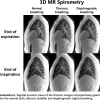3D Magnetic Resonance Spirometry
- PMID: 32541799
- PMCID: PMC7295793
- DOI: 10.1038/s41598-020-66202-7
3D Magnetic Resonance Spirometry
Erratum in
-
Publisher Correction: 3D Magnetic Resonance Spirometry.Sci Rep. 2020 Sep 24;10(1):16012. doi: 10.1038/s41598-020-72363-2. Sci Rep. 2020. PMID: 32968093 Free PMC article.
Abstract
Spirometry is today the gold standard technique for assessing pulmonary ventilatory function in humans. From the shape of a flow-volume loop measured while the patient is performing forced respiratory cycles, the Forced Vital Capacity (FVC) and the Forced Expiratory Volume in one second (FEV1) can be inferred, and the pulmonologist is able to detect and characterize common respiratory afflictions. This technique is non-invasive, simple, widely available, robust, repeatable and reproducible. Yet, its outcomes rely on the patient's cooperation and provide only global information over the lung. With 3D Magnetic Resonance (MR) Spirometry, local ventilation can be assessed by MRI anywhere in the lung while the patient is freely breathing. The larger dimensionality of 3D MR Spirometry advantageously allows the extraction of original metrics that characterize the anisotropic and hysteretic regional mechanical behavior of the lung. Here, we demonstrated the potential of this technique on a healthy human volunteer breathing along different respiratory patterns during the MR acquisition. These new results are discussed with lung physiology and recent pulmonary CT data. As respiratory mechanics inherently support lung ventilation, 3D MR Spirometry may open a new way to non-invasively explore lung function while providing improved diagnosis of localized pulmonary diseases.
Conflict of interest statement
Dr. Tanguy Boucneau and Dr. Brice Fernandez are today employees of the company GE Healthcare. The other authors declare no conflicts of interest.
Figures







References
Publication types
MeSH terms
Grants and funding
LinkOut - more resources
Full Text Sources
Research Materials

